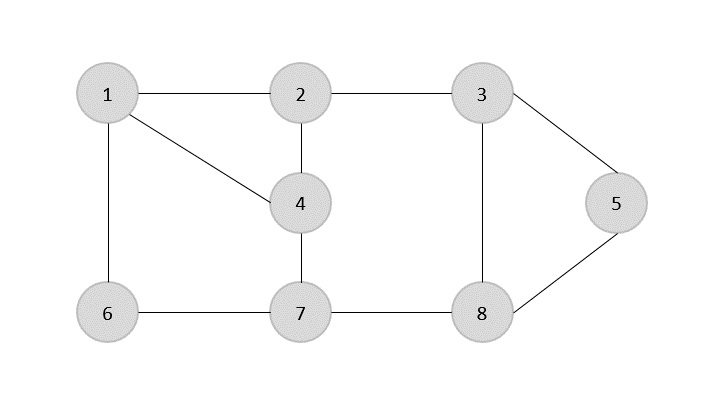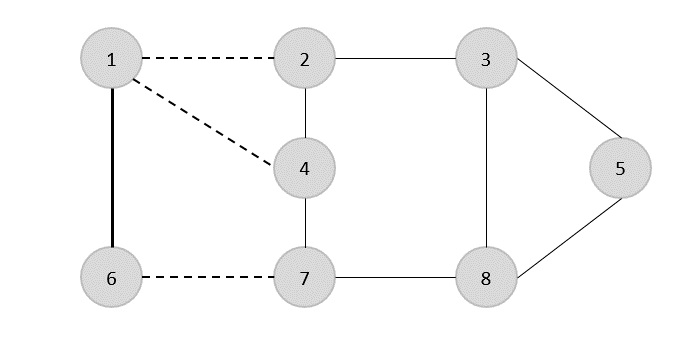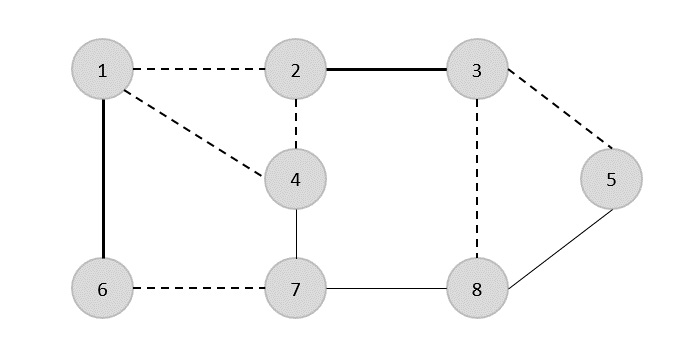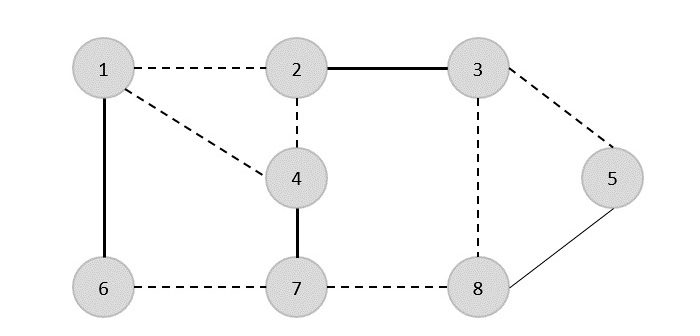
- 算法设计与分析
- 家
- 算法基础知识
- DAA - 简介
- DAA - 算法分析
- DAA-分析方法
- 渐近符号和先验分析
- 时间复杂度
- 马斯特定理
- DAA - 空间复杂性
- 分而治之
- DAA-分而治之
- DAA - 最大最小问题
- DAA-归并排序
- DAA-二分查找
- 施特拉森矩阵乘法
- 唐叶算法
- 河内塔
- 贪心算法
- DAA-贪婪法
- 旅行商问题
- Prim 的最小生成树
- 克鲁斯卡尔的最小生成树
- Dijkstra 的最短路径算法
- 地图着色算法
- DAA-分数背包
- DAA - 带截止日期的作业排序
- DAA - 最佳合并模式
- 动态规划
- DAA-动态规划
- 矩阵链乘法
- 弗洛伊德·沃歇尔算法
- DAA - 0-1 背包
- 最长公共子序列
- 旅行商问题| 动态规划
- 随机算法
- 随机算法
- 随机快速排序
- 卡格的最低削减
- 费舍尔-耶茨洗牌
- 近似算法
- 近似算法
- 顶点覆盖问题
- 设置封面问题
- 旅行推销员近似算法
- 排序技巧
- DAA-快速排序
- DAA-冒泡排序
- DAA——插入排序
- DAA-选择排序
- DAA——希尔排序
- DAA-堆排序
- DAA——桶排序
- DAA——计数排序
- DAA - 基数排序
- 搜索技巧
- 搜索技术介绍
- DAA - 线性搜索
- DAA-二分查找
- DAA - 插值搜索
- DAA - 跳转搜索
- DAA - 指数搜索
- DAA - 斐波那契搜索
- DAA - 子列表搜索
- DAA-哈希表
- 图论
- DAA-最短路径
- DAA - 多级图
- 最优成本二叉搜索树
- 堆算法
- DAA-二叉堆
- DAA-插入法
- DAA-Heapify 方法
- DAA-提取方法
- 复杂性理论
- 确定性计算与非确定性计算
- DAA-最大派系
- DAA - 顶点覆盖
- DAA - P 级和 NP 级
- DAA-库克定理
- NP 硬课程和 NP 完全课程
- DAA - 爬山算法
- DAA 有用资源
- DAA - 快速指南
- DAA - 有用的资源
- DAA - 讨论
设计与分析顶点覆盖
无向图G = (V, E)的顶点覆盖是顶点V ' ⊆ V的子集,这样如果边(u, v)是G的边,则V中的u或V '中的v或两个都。
在给定的无向图中找到最大尺寸的顶点覆盖。这个最优顶点覆盖是 NP 完全问题的优化版本。然而,找到接近最佳的顶点覆盖并不难。
APPROX-VERTEX_COVER (G: Graph) c ← { } E' ← E[G]
while E' is not empty do
Let (u, v) be an arbitrary edge of E' c ← c U {u, v}
Remove from E' every edge incident on either u or v
return c
例子
给定图的边集是 -
{(1,6),(1,2),(1,4),(2,3),(2,4),(6,7),(4,7),(7,8),( 3,8),(3,5),(8,5)}

现在,我们首先选择任意边 (1,6)。我们消除所有与顶点 1 或 6 相关的边,并添加边 (1,6) 进行覆盖。

在下一步中,我们随机选择了另一条边 (2,3)

现在我们选择另一条边 (4,7)。

我们选择另一条边 (8,5)。

因此,该图的顶点覆盖是{1,2,4,5}。
分析
不难看出,该算法的运行时间为O(V + E),用邻接表来表示E '。
例子
#include <stdio.h>
#include <stdbool.h>
#define MAX_VERTICES 100
int graph[MAX_VERTICES][MAX_VERTICES];
bool included[MAX_VERTICES];
// Function to find Vertex Cover using the APPROX-VERTEX_COVER algorithm
void approxVertexCover(int vertices, int edges) {
bool edgesRemaining[MAX_VERTICES][MAX_VERTICES];
for (int i = 0; i < vertices; i++) {
for (int j = 0; j < vertices; j++) {
edgesRemaining[i][j] = graph[i][j];
}
}
while (edges > 0) {
int u, v;
for (int i = 0; i < vertices; i++) {
for (int j = 0; j < vertices; j++) {
if (edgesRemaining[i][j]) {
u = i;
v = j;
break;
}
}
}
included[u] = included[v] = true;
for (int i = 0; i < vertices; i++) {
edgesRemaining[u][i] = edgesRemaining[i][u] = false;
edgesRemaining[v][i] = edgesRemaining[i][v] = false;
}
edges--;
}
}
int main() {
int vertices = 8;
int edges = 10;
int edgesData[10][2] = {{1, 6}, {1, 2}, {1, 4}, {2, 3}, {2, 4},
{6, 7}, {4, 7}, {7, 8}, {3, 5}, {8, 5}};
for (int i = 0; i < edges; i++) {
int u = edgesData[i][0];
int v = edgesData[i][1];
graph[u][v] = graph[v][u] = 1;
}
approxVertexCover(vertices, edges);
printf("Vertex Cover: ");
for (int i = 1; i <= vertices; i++) {
if (included[i]) {
printf("%d ", i);
}
}
printf("\n");
return 0;
}
输出
Vertex Cover: 1 3 4 5 6 7
#include <iostream>
#include <vector>
using namespace std;
const int MAX_VERTICES = 100;
vector<vector<int>> graph(MAX_VERTICES, vector<int>(MAX_VERTICES, 0));
vector<bool> included(MAX_VERTICES, false);
// Function to find Vertex Cover using the APPROX-VERTEX_COVER algorithm
void approxVertexCover(int vertices, int edges) {
vector<vector<bool>> edgesRemaining(vertices, vector<bool>(vertices, false));
for (int i = 0; i < vertices; i++) {
for (int j = 0; j < vertices; j++) {
edgesRemaining[i][j] = graph[i][j];
}
}
while (edges > 0) {
int u, v;
for (int i = 0; i < vertices; i++) {
for (int j = 0; j < vertices; j++) {
if (edgesRemaining[i][j]) {
u = i;
v = j;
break;
}
}
}
included[u] = included[v] = true;
for (int i = 0; i < vertices; i++) {
edgesRemaining[u][i] = edgesRemaining[i][u] = false;
edgesRemaining[v][i] = edgesRemaining[i][v] = false;
}
edges--;
}
}
int main() {
int vertices = 8;
int edges = 10;
int edgesData[10][2] = {{1, 6}, {1, 2}, {1, 4}, {2, 3}, {2, 4},
{6, 7}, {4, 7}, {7, 8}, {3, 5}, {8, 5}};
for (int i = 0; i < edges; i++) {
int u = edgesData[i][0];
int v = edgesData[i][1];
graph[u][v] = graph[v][u] = 1;
}
approxVertexCover(vertices, edges);
cout << "Vertex Cover: ";
for (int i = 1; i <= vertices; i++) {
if (included[i]) {
cout << i << " ";
}
}
cout << endl;
return 0;
}
输出
Vertex Cover: 1 3 4 5 6 7
import java.util.Arrays;
public class VertexCoverProblem {
static final int MAX_VERTICES = 100;
static int[][] graph = new int[MAX_VERTICES][MAX_VERTICES];
static boolean[] included = new boolean[MAX_VERTICES];
// Function to find Vertex Cover using the APPROX-VERTEX_COVER algorithm
static void approxVertexCover(int vertices, int edges) {
int[][] edgesRemaining = new int[vertices][vertices];
for (int i = 0; i < vertices; i++) {
edgesRemaining[i] = Arrays.copyOf(graph[i], vertices);
}
while (edges > 0) {
int u = -1, v = -1;
for (int i = 0; i < vertices; i++) {
for (int j = 0; j < vertices; j++) {
if (edgesRemaining[i][j] == 1) {
u = i;
v = j;
break;
}
}
}
// Check if there are no more edges remaining
if (u == -1 || v == -1) {
break;
}
included[u] = included[v] = true;
for (int i = 0; i < vertices; i++) {
edgesRemaining[u][i] = edgesRemaining[i][u] = 0;
edgesRemaining[v][i] = edgesRemaining[i][v] = 0;
}
edges--;
}
}
public static void main(String[] args) {
int vertices = 8;
int edges = 10;
int[][] edgesData ={{1, 6}, {1, 2}, {1, 4}, {2, 3}, {2, 4},
{6, 7}, {4, 7}, {7, 8}, {3, 5}, {8, 5}};
for (int i = 0; i < edges; i++) {
int u = edgesData[i][0];
int v = edgesData[i][1];
graph[u][v] = graph[v][u] = 1;
}
approxVertexCover(vertices, edges);
System.out.print("Vertex Cover: ");
for (int i = 1; i <= vertices; i++) {
if (included[i]) {
System.out.print(i + " ");
}
}
System.out.println();
}
}
输出
Vertex Cover: 1 3 4 5 6 7
MAX_VERTICES = 100
graph = [[0 for _ in range(MAX_VERTICES)] for _ in range(MAX_VERTICES)]
included = [False for _ in range(MAX_VERTICES)]
# Function to find Vertex Cover using the APPROX-VERTEX_COVER algorithm
def approx_vertex_cover(vertices, edges):
edges_remaining = [row[:] for row in graph]
while edges > 0:
for i in range(vertices):
for j in range(vertices):
if edges_remaining[i][j]:
u = i
v = j
break
included[u] = included[v] = True
for i in range(vertices):
edges_remaining[u][i] = edges_remaining[i][u] = False
edges_remaining[v][i] = edges_remaining[i][v] = False
edges -= 1
if __name__ == "__main__":
vertices = 8
edges = 10
edges_data = [(1, 6), (1, 2), (1, 4), (2, 3), (2, 4),
(6, 7), (4, 7), (7, 8), (3, 5), (8, 5)]
for u, v in edges_data:
graph[u][v] = graph[v][u] = 1
approx_vertex_cover(vertices, edges)
print("Vertex Cover:", end=" ")
for i in range(1, vertices + 1):
if included[i]:
print(i, end=" ")
print()
输出
Vertex Cover: 1 3 4 5 6 7